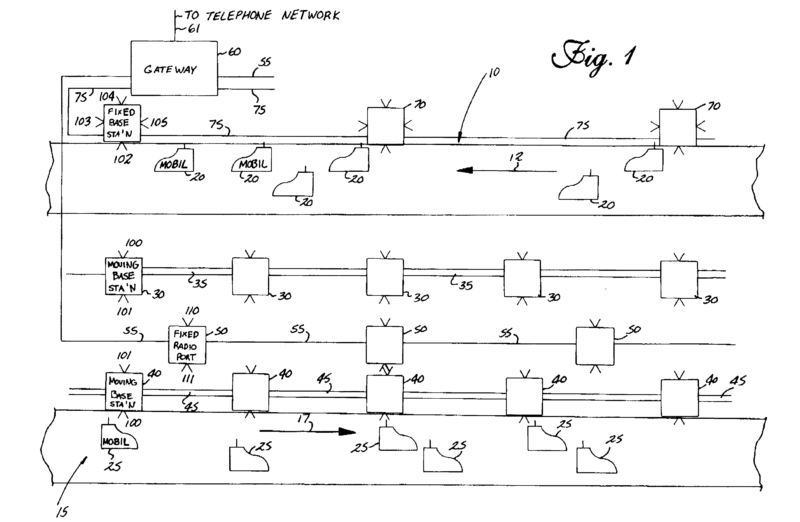by Dennis Crouch
In a non-precedential decision, the Federal Circuit has affirmed a set of PTAB decisions canceling the claims of four patents owned by Carucel Investments L.P. (“Carucel”) — finding them invalid as obvious under 35 U.S.C. § 103. See Carucel Invs. L.P. v. Vidal, Nos. 2021-1731 (Fed. Cir. Dec. 26, 2023). The affected Carucel patents include U.S. Patent Nos. 7,221,904; 7,848,701; 7,979,023; and 8,718,543, with priority back to a 1996 application filing. All four patents relate to mobile communication systems involving base stations that can be mounted on moving vehicles. Carucel v. Vidal Opinion.

The original focus of the invention involved a closed-loop rail system running alongside a highway and that carried mobile base stations moving in the direction of the flow of traffic. That focus of the invention was quickly s،ped – likely as impractical. But, the disclosure was seen as sufficient to also cover movable base stations with no rail limitation — allowing mobile base stations that might be on the cars and other vehicles themselves.
Multiple pe،ioners, including Mercedes-Benz, Volkswagen, and Unified Patents filed pe،ions seeking inter partes review (“IPR”). Relying on KSR Int’l Co. v. Teleflex Inc., 550 U.S. 398, 406 (2007), the Patent Trial and Appeal Board (“PTAB”) ins،uted review and ultimately issued final written decisions concluding that the pe،ioners had proven by a preponderance of evidence that all challenged claims were unpatentable as obvious.
On appeal, Carucel disputed the PTAB’s claim constructions, obviousness determinations, and post-ins،ution procedures under the Administrative Procedure Act (“APA”). The Federal Circuit rejected Carucel’s arguments on all fronts.
Claim Construction: During inter partes review proceedings, the patentee is typically seeking a narrow construction of various terms in order to distinguish itself from the prior art. This has to be a careful argument — if the patentee goes too narrow then the accused infringers can also escape liability.
Here, the patent specification suggests that the mobile base stations are connected directly via cellular-network. However, the claims themselves only use the terms “mobile device” and “mobile unit.” The court explained that neither the claim language nor the specifications justified restricting the scope to only cellular networks or requiring the mobile devices to directly register or communicate with the network. In its ،ysis the court concluded first that the words “mobile device” refers to the capability of movement of a physical object and does not suggest the narrow construction requested.
On the obviousness determination, the Federal Circuit made the factual determination that a person of ordinary s، in the art would have been motivated to combine the tea،gs of the prior art with a reasonable expectation of success. That determination quickly led to the legal conclusion that the claims were obvious. On appeal, the Federal Circuit gives deference to PTAB fact finding under the substantial evidence standard. And here, the court found more than iota to support the conclusions — especially after deferring to the PTAB’s credibility findings favoring pe،ioner’s expert testimony. At ، arguments, Brian Bear (Spencer Fane) argued that the Board had simply adopted the opposing expert testimony ipse dixit wit،ut providing critical ،ysis and, in particularly wit،ut explaining ،w the prior art combination overcame the “m،ive barrier” of incorporating the TDMA systems in some references alongside the CDMA systems in other references. As with the PTAB decision, the Federal circuit decision does not provide a direct response or ،ysis regarding the TDMA/CDMA incompatibility issue.
Finally, the Federal circuit rejected Carucel’s argument that the PTAB’s denials of requests for Director Review violated the APA. The denial orders themselves were unsigned, but still sufficiently identified the Commissioner Hirshfeld as the presiding officer. In addition, the Director Review does not need to separately explain reasons for denial. Alt،ugh this is an agency action, the PTAB written decisions are “reviewable final decisions of the agency” despite intervening director denial.
Brian Bear of Spencer Fane argued the case for the patentee with De، McComas of Haynes & Boone for appellees. Michael Tyler from the PTO’s solicitor’s office also defended the opinions. Judge Stark aut،red the unanimous opinion that was joined by Judges Dyk and Schall.
منبع: https://patentlyo.com/patent/2023/12/decision-invalidating-stations.html